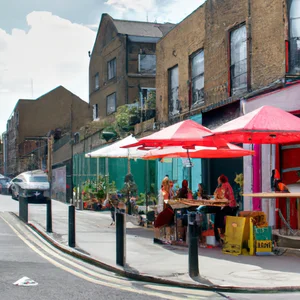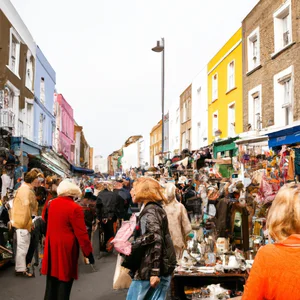Book your experience
Bank of England Museum: the story of the Old Lady of Threadneedle Street
If we talk about the Bank of England Museum, well, it’s like taking a dive into the history of the “Old Lady of Threadneedle Street”, which, for those who don’t know, is an affectionate nickname for the bank. It’s a truly fascinating place, where history is intertwined with the present, and makes you understand a little more about how the economy works, which, let’s face it, is a topic that may seem boring, but in reality it’s something else entirely. couple of sleeves.
When I went there for the first time, I was a bit sceptical, like “what’s so interesting about a bank?”, but I had to change my mind. At the entrance you are greeted by an atmosphere that makes you feel like you are about to enter a period film. There are these historical objects that tell stories of a time gone by, and each piece seems to have a soul, you know?
There is a section on the history of currency that particularly struck me. Like, you realize how much money has changed over the years, from gold and silver coins to banknotes that almost look like pieces of art. And to think that once upon a time there were also paper banknotes which, apparently, were more like pieces of cloth! I don’t know, but it felt a little surreal, like I was reading a fantasy novel.
The thing that really made me think was the part dedicated to the economic crisis. There is an installation showing how the Bank of England had to deal with historical events such as the Great Depression. In short, it’s a bit like when you’re in the middle of a storm and you’re trying to keep the boat afloat. Not easy, huh?
I think if you’re a bit interested in economics or are simply curious about how things work in the world of finance, a visit to the museum could prove to be a great adventure. And who knows, maybe you might even discover something new about how to manage your savings, which never hurts!
In short, if you are in the area, don’t miss the opportunity to take a look. It’s a bit like being in a time machine, except you don’t have to worry about time travel, just step in and be surprised. Besides, who doesn’t love a bit of history, right?
Discover the history of the “Old Lady of Threadneedle Street”
A Personal Introduction
I remember the first time I crossed the threshold of the Bank of England Museum, a place that exudes history and culture. As I walked through the majestic door of this building, a feeling of respect and curiosity enveloped me. The “Old Lady of Threadneedle Street”, as the Bank of England is affectionately known, is much more than a financial institution; it is a symbol of the UK’s economic history, and the museum offers a unique window into its fascinating evolution.
A Journey Through Time
Founded in 1694, the museum tells not only the history of the bank, but also that of the entire nation. Through historical documents, rare banknotes and interviews with economists, visitors can explore how the Bank has navigated economic storms and political crises. The exhibitions bring to light crucial events, such as the bank’s role during the world wars and the 2008 crisis, offering an insight into the power and responsibility that the Bank has assumed over the centuries.
An Insider’s Tip
A little-known tip is to ask museum staff to show you the ‘Gold Bar’, a real gold bar weighing around 12 kilograms. This piece of history, often overlooked by visitors, represents the economic power of the Bank and its commitment to financial stability. The possibility of admiring such a precious and symbolic object makes the visit even more memorable.
Cultural and Historical Impact
The Bank of England has had a profound impact not only on the British economy but also on popular culture. Phrases like “Old Lady” not only evoke the image of an old lady, but also represent a figure of wisdom and stability in times of uncertainty. The museum, with its displays, provides a context that helps visitors understand the importance of this institution in shaping modern society.
Sustainability and Responsibility
In an era where sustainability is key, the museum has adopted eco-friendly practices, such as the use of renewable energy and the promotion of green initiatives. Visiting it is a way to participate in responsible tourism, helping to preserve cultural heritage for future generations.
A Unique Atmosphere
Walking through the museum’s rooms, natural light filters through the large windows, reflecting on the history-adorned walls. The interactive exhibitions make the experience engaging, allowing visitors to experience history first-hand. Every corner tells a story, every object is a key to understanding the past.
Recommended Activity
After exploring the museum, I recommend taking part in one of the thematic guided tours offered. These experiences offer unique insights and fascinating stories that will enrich your understanding of the Bank and its history.
Myths and Misconceptions
A common myth is that the museum is only for economists or financial experts. In fact, it’s an accessible and intriguing place for anyone curious about the history of the United Kingdom. The stories told in the museum are compelling and relevant to everyone, regardless of background.
Final reflection
As I left the museum, I asked myself: How can a single institution impact the lives of millions of people? The story of the “Old Lady of Threadneedle Street” is not just that of a bank; it is a story of resilience, innovation and impact. Anyone visiting London should take the time to discover this fascinating history and reflect on how the past can guide our future.
Discover the story of the “Old Lady”
A journey into the heart of British finance
I vividly remember my first visit to the Bank of England, an imposing structure that stands in the heart of the City of London. As I crossed the threshold of this historic monument, I was greeted by an atmosphere of grandeur and history. The guide, a passionate economic history expert, told us the legend of the “Old Lady”, an affectionate nickname that Londoners have given to the bank. It’s incredible to think that a simple financial institution can encompass centuries of events that have shaped not only the British economy, but also the world economy.
Interactive exhibitions: a dialogue with history
Within the Bank of England Museum, interactive displays are designed to engage visitors in a way that goes beyond simple observation. You can try to mint a coin or even manage a financial crisis in real time. These carefully curated installations offer a direct look at the dynamics that govern the economy, making history alive and palpable. According to the Bank of England’s official website, the displays have recently been updated to reflect the latest innovations in finance.
An insider tip
If you want an even more in-depth experience, I recommend visiting the museum during the week, when there are fewer tourists. This will allow you to have a more personal interaction with the guides, who often offer unique insights and stories you might not hear in a large group.
The cultural impact of the Bank of England
The Bank of England is not just a central bank; it is a symbol of stability and innovation. Founded in 1694, it has played a crucial role in supporting Britain during wars and economic crises. Its history is intertwined with global events, such as the Industrial Revolution and the two world wars, profoundly influencing British culture and identity.
Responsible and sustainable tourism
In an era where tourism sustainable is more important than ever, the museum promotes ecological practices. Using recycled materials for exhibitions and taking measures to reduce the environmental impact of visits is part of their mission. Choosing to travel responsibly, for example by using public transport to reach the City, helps preserve this heritage for future generations.
Soak up the atmosphere
Imagine walking through the beautifully decorated halls, with the sound of footsteps echoing off the historic walls. The soft lights and air full of history create a unique atmosphere, ideal for deep reflections on how money has influenced the lives of billions of people.
Recommended experience
Don’t miss the opportunity to join one of the thematic guided tours, where industry experts discuss the evolution of money and economic policies. It’s a fascinating way to deepen your understanding of not only the bank, but also its role in the broader historical context.
Myths and reality
A common misconception is that the Bank of England is simply a place where banknotes are printed. In reality, the bank is a complex organism that manages monetary policy, regulates banks and promotes economic stability. Understanding these challenges brings a new dimension to your visit.
Final reflection
After exploring the history of the “Old Lady”, I invite you to reflect: how does economic history influence your daily choices? The next time you use a banknote, you might consider the stories and challenges that led to its creation. History is not just a tale of the past; it is a lens through which we can see our present and our future.
A journey through time: historical coins
A personal experience
I still remember my first visit to the Bank of England Museum, when I found myself in front of a glittering display of historic coins. Each piece seemed to tell a story, a tangible link to the past. Among the various coins, one in particular caught my attention: a copper coin from 1666, emblematically minted shortly after the Great Fire of London. At that moment, I felt transported back in time, imagining merchants using it for their daily transactions.
Practical information
The museum offers a large collection of historical coins, with over 600,000 pieces on display. It is open from Monday to Friday, from 10:00 to 17:00, and entry is free for all visitors. For up-to-date information, you can consult the official website of the Bank of England Museum (bankofengland.co.uk).
An insider tip
If you want a truly unique experience, try attending one of the numismatics workshops held regularly at the museum. These workshops will not only allow you to handle historic coins, but also learn identification and preservation techniques that experienced collectors use. It’s a rare opportunity to come into direct contact with monetary history.
Cultural and historical impact
Coins are not simply objects of value; they are symbols of the culture and economy of an era. The history of British coins reflects the country’s social and political changes, from the Viking invasions to the Victorian era. Each coin is a silent witness to events that shaped the nation, making a visit to the museum a fascinating journey through time.
Sustainability and responsible tourism
The museum promotes responsible tourism practices, encouraging visitors to reflect on the importance of preserving monetary history. Part of the funds raised through visits are reinvested in education and conservation programs, thus sustaining culture and history for future generations.
Immersive atmosphere
Walking through the displays, you will find yourself surrounded by a warm light that highlights the details of the ancient coins. The showcases, elegantly arranged, tell stories of emperors, battles and discoveries. You can almost hear the echoes of transactions that took place centuries ago. It is an engaging experience, which invites you to reflect on the value of money and its impact on society.
Suggested activity
Don’t miss the chance to explore the section dedicated to rare coins, where you can admire magnificent specimens such as the 1887 Double Sovereign. After your visit, consider taking some time to stroll around the surrounding gardens, reflecting on what you have just discovery.
Myths and misconceptions
A common misconception is that historic coins are exclusively for collectors. In reality, every visitor can appreciate the beauty and history of these objects, regardless of their previous knowledge. Coins tell universal stories that can fascinate anyone.
Final reflection
After exploring the world of historical coins, I invite you to reflect: how much value do we attribute to money today compared to what was significant in past centuries? What story will our current currency tell in a hundred years? A journey through time that invites us to consider the present through the lens of the past.
Curiosities about the creation of the Bank of England
A few years ago, during a visit to London, I found myself in front of the imposing façade of the Bank of England, a building that embodies centuries of history and economic power. As I looked at the majestic arches and intricate decorations, I had an epiphany: this was not just a financial institution, but a symbol of resilience and innovation. The history of the Bank of England is full of curiosities that reveal much more than appears at first glance.
A little history
Founded in 1694 to finance the war against France, the Bank of England emerged at a time when England was trying to establish its position on the European landscape. The bank’s creation marked a turning point in banking practices, introducing concepts such as fractional reserve banking and government debt. Today, it is not only the central bank of the United Kingdom, but also a beacon of economic stability.
Practical information
Visiting it is an experience that cannot be missed. The Bank of England offers guided tours that wind through its historic rooms and interactive exhibitions. Opening hours vary, but generally, visits can be booked from Monday to Friday. For up-to-date information, consult the Bank of England’s official website, where you will also find information on temporary exhibitions.
A tip for insiders
A well-kept secret is that, during guided tours, you can access an exclusive room where historic coins are kept, including the famous “pound coins” that have fascinated generations. Often, visitors are unaware of this opportunity! Ask your guide to show it to you: it’s a rare opportunity to see a piece of monetary history up close.
The cultural impact
The Bank of England has played a crucial role not only in the economy, but also in British culture. With his banal language and power, he influenced the way the English perceive money and stability. The creation of the bank led to the formation of a modern banking system, making England a world leader in the financial field.
Sustainable tourism practices
The Bank of England promotes responsible tourism by encouraging visitors to use public transport to reach the building. This is a great way to reduce your environmental impact, especially in a city like London where traffic can be congested. Furthermore, the The museum also offers information on green initiatives and sustainability in the financial sector.
Live the experience
During your visit, don’t forget to stop in the museum café to enjoy a cup of English tea accompanied by a traditional sweet. This break will not only enrich your experience, but will allow you to reflect on the complexity of British financial history.
Myths and misconceptions
A common misconception is that the Bank of England prints money at will. In reality, money creation is a complex process, regulated by laws and economic policies. The bank acts as a guardian of financial stability, rather than simply a printer of banknotes.
In conclusion, the history of the Bank of England offers a fascinating glimpse into economic power and its evolution over the centuries. What new discoveries do you expect to make during your visit?
Culinary experience: the museum café
When I crossed the threshold of the café located inside the Bank of England museum, I did not expect to be greeted by such a vibrant and welcoming atmosphere. The scent of fresh coffee mixed with the historic air that permeates the building, a perfect blend of past and present. While sipping a creamy cappuccino, I got to observe a group of visitors exchanging stories and laughing, making the experience even more memorable.
A coffee with a history
The museum café is not just a place to refresh yourself; it’s an experience in itself. Recently renovated, it offers a menu that celebrates local and sustainable ingredients, an aspect that cannot go unnoticed. According to an article by Time Out London, the café only uses ethically sourced coffee, contributing to responsible tourism practices. Plus, the staff is knowledgeable and ready to recommend daily specials, often inspired by the bank’s history.
An insider tip
A little-known tip? Don’t miss the homemade desserts, especially the scones with jam and cream. These little treasures are prepared every morning and are a delicious way to end your coffee break. Many visitors simply order a drink, but skipping the desserts would be a real shame!
Cultural impact
The presence of a café within a historic institution such as the Bank of England represents a significant step towards inclusiveness. It is a place where history intertwines with everyday life, allowing visitors to relax and reflect on the importance of the bank in the economic and social context of the United Kingdom. Here, conversations intertwine with the stories of coins and banknotes, making the café a cultural meeting point.
Sustainable tourism practices
The cafe is not only committed to using sustainable ingredients, but also promotes the use of biodegradable materials for its packaging and tableware. This commitment reflects a growing interest in eco-responsible tourism, where every visit helps preserve the environment.
An experience worth trying
If you have time, I recommend attending one of the coffee tasting sessions that the museum café organizes regularly. It’s a unique opportunity to delve into coffee culture and learn from expert baristas, who share fascinating stories about the origins of coffee and its evolution.
Myths and misconceptions
One of the most common myths is that cafes inside museums are always expensive and of low quality. On the contrary, the museum café offers competitive prices and a quality that is positively surprising. You can enjoy great coffee without emptying your wallet.
Final reflection
As I sipped my coffee and observed the elegance of the place, I began to reflect on how enriching combining culture and gastronomy can be. Have you ever wondered how a simple coffee can transform your museum experience? Next time you visit a museum, take a moment to sit back and soak up the atmosphere. You may find that each sip tells a story.
Art and architecture: a hidden treasure
A personal experience
I still remember the first time I walked through the doors of the Bank of England. A slight shiver ran down my spine as I found myself in front of that majestic neoclassical façade, adorned with imposing columns and statues that seemed to tell stories of past centuries. It was like entering a history book, and the atmosphere inside was permeated with a sense of gravity and importance. Here, where art blends with architecture, lies a treasure that few visitors take the time to explore.
Practical information
The Bank of England is not only one of the most influential financial institutions in the world, but also a stunning example of historic architecture. The museum is open every day, with free admission, making it easy for anyone to access this cultural heritage. For those who want to delve deeper into the topic, I highly recommend taking one of the guided tours available, where expert storytellers illustrate the architectural and artistic details in an engaging way. You can find more information on the Bank of England’s official website and book your visit.
Unconventional advice
A well-kept secret is that the museum’s main entrance, while majestic, is just the beginning. If you want to discover a remote and fascinating corner, head to the bank’s internal garden. Here, among the manicured plants and contemporary sculptures, you can enjoy a moment of tranquility, away from the hustle and bustle of London. This space is often overlooked by visitors and offers a unique perspective on the fusion of nature and architecture.
Cultural and historical impact
The architecture of the Bank of England reflects not only the economic power, but also the social and political changes of Great Britain. Built in 1734, the bank has witnessed crucial events, such as wars, economic crises and urban transformations. Every element of its design, from the great atrium to the treasury, is a symbol of stability and innovation, representing the beating heart of the British economy.
Sustainability in tourism
In recent years, the Bank of England has adopted sustainability practices that aim to reduce the museum’s environmental impact. These include the use of recycled materials for exhibitions and the promotion of eco-sustainable events. By participating in these initiatives, visitors can contribute to responsible and conscious tourism, thus preserving this heritage for future generations.
Immersion in the atmosphere
Imagine walking the corridors of the Bank of England, your shoes clicking on the marble floor, as the scent of history and knowledge envelops you. The walls, adorned with works of art that tell the economic history of the country, seem to whisper forgotten secrets. Every corner is imbued with an aura of dignity and respect, capable of transporting you back in time.
An activity worth trying
Don’t miss the chance to attend an art and architecture workshop hosted by the museum, where you can explore and create works inspired by the Bank of England’s masterpieces. This experience will not only enrich your visit, but will also allow you to fully immerse yourself in the local artistic culture.
Myths to dispel
A common misconception is that the Bank of England is solely a place for financial experts and bankers. In reality, the bank is open to all, and its artistic and architectural exhibitions are accessible even to novices. Don’t be intimidated: the beauty of this place is that it has something to offer anyone who is willing to explore.
Final reflection
Next time you are in London, we invite you to take a break from the usual tourist attractions and consider the Bank of England as an unmissable stop. Have you ever wondered how art and architecture can tell the deepest stories of a nation? The answer awaits you behind the doors of this hidden treasure.
Sustainability: the museum and eco-tourism
During one of my latest visits to the Bank of England Museum, I had the opportunity to participate in a sustainability workshop, where I learned how this historic institution is doing its part to protect our planet. As I immersed myself in the details of the eco-friendly practices adopted by the museum, I realized that sustainability is not just a trend, but a fundamental value that pervades the entire museum project.
Commitment to the environment
The museum has implemented several green initiatives over the years. According to their official website, LED lighting has been installed throughout the exhibition space, significantly reducing energy consumption. Additionally, the museum has initiated recycling and composting programs, working with local suppliers to reduce the environmental impact of their events and daily operations. The collection of artworks was also curated taking into consideration sustainable and low-impact materials.
An insider tip
If you want a more authentic experience, I recommend asking the museum staff about their eco-friendly guided tours. These visits will not only take you to explore the history of the Bank of England, but will also give you an insight into how the museum is contributing to sustainability, making your tour informative and knowledgeable. It is a little-known option, but extremely enriching.
The cultural impact of sustainability
Sustainability has a strong impact not only on the environment, but also on the culture and identity of a city. The Bank of England Museum, as a historic institution, is demonstrating that even the most deeply rooted realities can evolve and adapt to the new needs of society. This approach has inspired other institutions to follow suit, creating a wider movement towards eco-tourism in London.
Responsible tourism practices
When visiting the museum, consider using public transportation to reach your destination. London is well connected with an efficient public transport network, and choosing these options reduces the environmental impact of your trip. Furthermore, the museum offers the possibility of taking home eco-friendly souvenirs, such as reusable bags and products made from recycled materials.
Immersion in the atmosphere
As you walk through the galleries, you may notice how each element has been designed to reduce energy consumption and environmental impact. The walls are adorned with information panels that tell stories of sustainability and innovation, creating an atmosphere that is as educational as it is engaging. Imagine walking through these spaces, surrounded by historical works of art that tell the story of the past while the museum looks to the future.
An activity worth trying
Don’t forget to attend one of the sustainability workshops the museum offers throughout the year. These hands-on activities will not only give you useful tools to adopt a more sustainable lifestyle, but will also allow you to connect with other visitors who share your passion for the environment.
Myths to dispel
A common misconception is that history museums cannot be sustainable. In fact, the Bank of England Museum is living proof that cultural heritage and eco-sustainability can coexist. The challenge lies in adapting traditional practices to an ever-changing world, and the museum is doing an excellent job in this regard.
Conclusion
As you leave the museum, ask yourself: How can I contribute to sustainability in my daily life? This reflection not only enriches your museum experience, but can also inspire you to become a more conscious caretaker of our planet. The Bank of England Museum is not just a place of history, but also a model of how we can all make a difference.
Special events: evenings at the museum
Imagine yourself in an elegant room, with soft lighting dancing on the historic walls of the Bank of England, while the echoes of intriguing conversations and subtle laughter fill the air. I was lucky enough to attend one of the special evenings organized by the Bank of England Museum, an experience that transformed the perception of this place from a simple custodian of money to a stage for vibrant and engaging events. During these evenings, the museum comes alive with interactive activities, expert conferences and artistic performances, making the history of finance not only accessible, but also fascinating.
Practical information
Special evenings are held regularly and offer a unique opportunity to explore the museum in a festive atmosphere. To stay updated on upcoming events, it is advisable to visit the museum’s official website or subscribe to the newsletter. Tickets are often limited, so booking in advance is essential to avoid disappointment.
An insider tip
A little-known tip is to arrive early and enjoy a drink at the museum café before the event starts. This will not only allow you to enjoy a delicious drink, but also to have a chat with other visitors or speakers in attendance, creating connections that could enrich your experience.
Cultural impact
Special evenings at the museum are not only a way to have fun, but also an important cultural initiative. They offer an opportunity to reflect on how the Bank of England has influenced not only the economic, but also the social and cultural landscape of the UK and beyond. Through debates and discussions, we can understand how economic decisions have a direct impact on people’s daily lives.
Sustainable tourism practices
The museum is committed to responsible tourism practices, promoting events that encourage local community participation and reduce environmental impact. Attending museum nights not only enriches your personal experience, but also supports an institution that is dedicated to sustainability.
Immerse yourself in the atmosphere
The atmosphere of an evening at the Bank of England Museum is truly unique. The sounds, colors and energy of the place will engage you, transforming your perception of finance. Imagine having a conversation with an economics expert while surrounded by historic works of art and fascinating artifacts.
Suggested activity
During one of these evenings, don’t miss the opportunity to participate in one of the interactive sessions, where you will have the opportunity to manipulate historical financial instruments and understand how markets have evolved over time. You can also ask questions to the speakers and delve deeper into topics that interest you most.
Myths to dispel
A common misconception is that museum evenings are reserved only for economics experts. In fact, the events are designed to attract a diverse audience, from the curious to the professionals, making finance a compelling topic for everyone.
Final reflection
Attending a special evening at the Bank of England Museum is more than just an event; it’s an opportunity to see economic history through a new and dynamic lens. What do you think about spending an evening immersed in the history of finance? It could be the beginning of a new passion for the economic world and its countless facets.
A unique point of view: thematic guided tours to Bank of England Museum
When I first entered the Bank of England Museum, I was ready to immerse myself in the stories of gold coins and bars. But what surprised me most were the thematic guided tours, real keys to open the doors of the past. Imagine having an expert at your side, ready to share anecdotes and curiosities that you wouldn’t find on normal exhibition cards. It’s like having a friend tell you the deepest secrets of the “Old Lady of Threadneedle Street”.
A guided journey through history
Thematic guided tours offer an experience that goes beyond mere observation. During my visit, I took a tour that focused on financial crises, a topic that, for many, might seem boring. In fact, it was like watching a gripping movie where the tension constantly builds. The museum’s experts know how to capture attention, making the story not only informative, but also compelling. I discovered fascinating details, such as the role of banking during the Great Depression and how economic decisions affect the lives of ordinary people.
Insider tips
If you are planning your visit, I recommend booking your guided tour in advance. Some tours, such as the one dedicated to the “Secrets of the Bank”, can fill up quickly. Additionally, asking to customize the tour to your specific interests is an often available option. The museum’s experts are excited to share their knowledge and can offer unique insights into topics of interest to you.
The cultural impact of finance
Thematic guided tours not only illuminate the bank’s past, but also offer an insight into British business culture. Understanding how the Bank of England has navigated financial storms over the centuries helps you perceive the importance of this institution in the current context. You’ll find yourself reflecting on how the economic principles that guided the bank’s decisions still influence global financial policies today.
Sustainability and responsibility
In an age where sustainability is key, the Bank of England Museum is making efforts to reduce its environmental impact. Taking a guided tour gives you the opportunity to learn about these initiatives and discover how education and awareness are at the heart of their mission.
An experience that will transform you
Don’t miss the opportunity to take part in a thematic guided tour during your visit to the museum. It’s a way to experience history in an engaging way, enriching your understanding of the world of finance. The next time you talk about economics with your friends, you’ll have unique anecdotes and insights to share.
Have you ever been to a museum that changed your perspective on a topic? What was your experience?
Forgotten stories: the role of the bank in wars
A personal journey into the past
I vividly remember the first time I visited the Bank of England Museum. As I explored the galleries, one exhibit in particular caught my attention: the one dedicated to the crucial role of the bank during the wars. I immersed myself in stories of how financial decisions shaped the course of history, and felt the atmosphere filled with drama and tension, almost as if the walls themselves could tell the secrets of a bygone era.
Practical information
The Bank of England Museum is open Tuesday to Sunday, with free entry. Located in the heart of London, easily accessible by tube (Bank stop), the museum offers a unique perspective on the nation’s economic history. Recently, the section that explores the role of the bank in the world wars has been renovated, with new interactive installations that enrich the visitor experience.
An insider tip
If you would like to delve further, consider joining a dedicated guided tour. These sessions, often led by expert historians, offer unique anecdotes and surprising revelations, such as how monetary policies influenced military strategies. A little-known piece of information is that many of the original documents are stored in the bank’s archives and can only be accessed upon request - a treasure for true history buffs!
Cultural and historical impact
The Bank of England’s role during wars was not limited to financial matters; it has had a profound impact on British society and how subsequent generations perceive conflict and resilience. The bank handled the financing of the war effort, influencing not only the economy, but also the morale of the population. Through his policies, he helped shape the nation, making it what it is today.
Responsible tourism
Visit the museum respecting sustainable tourism practices. Remember to use public transport and respect the exhibition spaces. The Bank of England is committed to sustainability, and the museum promotes events and initiatives to raise awareness of eco-tourism issues.
An experience not to be missed
During your visit, don’t miss the opportunity to look closely at the collection of historic coins used during conflicts. I recommend you also spend time in the interactive corner, where you can “make decisions” like a banker of the time, exploring the consequences of your choices in real time.
Myths and misconceptions
A common myth is that the Bank of England was just a bureaucratic entity, with no real influence in policy decisions. In reality, his actions have had significant and often controversial weight, helping to shape the destiny of the nation and beyond.
A final reflection
Thinking about the role of banking in wars, I wonder: how will today’s economic decisions affect our future? History has much to teach us, and each visit to the museum invites us to reflect on how the past continues to influence the present. Are you ready to discover the forgotten stories that shaped our world?

 Architecture and Design
Architecture and Design Cities and Regions
Cities and Regions Culture and History
Culture and History Events and Festivals
Events and Festivals Fashion and Shopping
Fashion and Shopping Food and Wine
Food and Wine Nature and Adventure
Nature and Adventure Unique Experiences
Unique Experiences



























